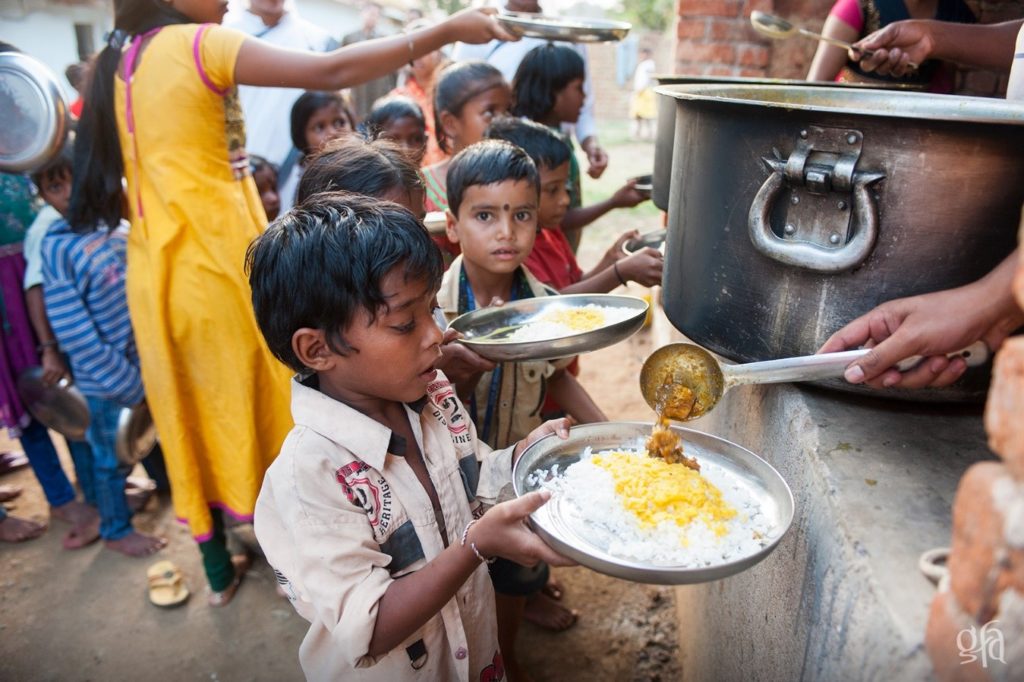SOUTH ASIA – Gospel for Asia (GFA) – More than 820 million people around the globe suffer from chronic hunger and malnutrition. Forty-five countries have “serious levels of hunger.” Hunger is the number one health risk in the world. Hunger is the root cause of “a staggering 3.5 million deaths” every year. Every 10 seconds, a child dies as a result of hunger.
According to Action Against Hunger, 18.7 million children suffer from “severe acute malnutrition.” Severe acute malnutrition evidences itself in one of two forms: marasmus or edema.
- Persons with marasmus appear shrunken and wasted with no muscle mass. Marasmus is most commonly noted in regions of abject poverty.
- Edema presents as swelling, especially in the face, arms, and legs. Severely weakened muscles become distended, resulting in cramping and muscular pain.
Both of these conditions can cause irreversible internal damage and deficiencies from which the individual may never be able to recover fully.
Yet, according to Mercy Corps, “The world produces enough food for everyone to live a healthy, productive life!”
What’s the problem?
The problem is not a lack of food. It is a lack of access to the right kinds of food. People in Guatemala, for instance, have plenty to eat, but they lack access to the right types of food. They suffer from malnutrition.
The problem the entire world over is not a lack of food, it is not having consistent access to nutritional food. Mercy Corps explains,
“There is 17 percent more food available per person than there was 30 years ago. And, if all the world’s food were evenly distributed, there would be enough for everyone to get 2,700 calories per day — even more than the minimum 2,100 [calorie] requirement for proper health.”
It is estimated that somewhere between 25 to 30 percent of food produced in developing countries is lost “due to inefficiencies in the supply chain.” With the increasing population of forcibly displaced persons, unless there is some effective intervention, the data will become even more unpalatable.
What about the future?
Hunger is an emergency that needs to be addressed now. Ask any hungry person. They are much less interested in future plans than how to sustain themselves and their families right now. They need a continual supply of nutritious food now.
This is one area where Gospel for Asia (GFA) plays a significant role across South Asia. Gospel for Asia (GFA) supplies free, nutritious meals to school-age children through its Bridge of Hope programs. Its Compassion Services arm feeds others, including widows, lepers, and victims of natural disasters. The faith-based NGO has worked for 40 years to meet the physical and spiritual needs of the people of South Asia.
Nonetheless, the future remains ominous unless state and international agencies begin addressing future hunger issues here and now. Mercy Corps is one of those agencies dedicated to building a more food secure future. They say that,
“The world’s population is projected to rise to around 10 billion by 2050 — up from more than 7 billion today. That means there will be over 2 billion more people who need food by 2050. Making sure there’s enough for everyone to eat will be an increasing concern as the population multiplies.
Even though we must increase production by 50 percent to keep up with the demand and find new, secure sources of food, the main challenge in the future fight against hunger will be the same one we’re facing today: ensuring that every family is able to access it.”
The answer to the title question is much more complicated than this article can address. We would, however, draw your attention to this growing concern. We serve a loving God who can supply all of our needs according to His riches in glory. And, He is willing to do that for every person and every nation that will turn their hearts toward him.
To read more news on World Hunger on Missions Box, go here.
Source:
- Mercy Corps, Quick facts: What you need to know about world hunger
- Times of India, India ranks 103 on global hunger index
- The Borgen Project, Top 10 facts about hunger in India
- Action Against Hunger, Official Website
Image Source:
- Gospel for Asia, Photo of the Day





